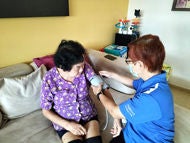What is - Chronic Obstructive Pulmonary Disease (COPD)

What is chronic obstructive pulmonary disease (COPD)?
Chronic obstructive pulmonary disease (COPD) is a disease where both lungs are damaged and the airways become irreversibly narrowed. It is also known as chronic obstructive airway disease (COAD) or chronic obstructive lung disease (COLD). Patients present with breathlessness on exertion that progresses over time. In the end, breathlessness may occur even at rest.
How prevalent is chronic obstructive pulmonary disease (COPD)?
COPD is a common condition. The World Health Organization places it as the third leading cause of death across the globe. In the most recent Global Burden of Disease study in 2019, 212.3 million cases were reported globally. There were also 3.3 million deaths worldwide due to COPD in that year.
Though the local prevalence is not known, COPD is within the top 10 leading causes of death in Singapore.
What are the types of chronic obstructive pulmonary disease (COPD)?
There are different types of COPD. The main types are:
- Chronic bronchitis – Long-term inflammation of the airways, leading to persistent cough with mucus, wheezing and breathlessness.
- Emphysema – Damage to the alveoli, reducing oxygen exchange and causing shortness of breath and fatigue.
Other forms of COPD include:
- Asthma-COPD Overlap (ACO) – A condition where features of both asthma and COPD are present, leading to variable airflow obstruction and inflammation.
- Alpha-1 Antitrypsin Deficiency COPD – A rare genetic form caused by low levels of alpha-1 antitrypsin, a protein that protects the lungs, leading to early-onset emphysema.
Symptoms of Chronic Obstructive Pulmonary Disease (COPD)
What are the symptoms of chronic obstructive pulmonary disease (COPD)?
Common symptoms of COPD develop gradually and worsen over time. These include:
- Persistent cough
- Phlegm
- Breathlessness, especially during physical activities
- Wheezing
- Chest tightness
- Frequent chest infections
Some individuals with COPD may experience flare-ups, in which the intensity of symptoms increases acutely beyond the usual day-to-day variability.
These flare-ups are called exacerbations and may require unscheduled or emergency use of healthcare services such as hospitalisation. Exacerbations are also a significant cause of death among those with COPD.
What are the potential complications of chronic obstructive pulmonary disease (COPD)?
Gas exchange problems
Damaged lungs due to COPD can result in a reduction of oxygen levels, and sometimes also an increase in carbon dioxide levels which cannot be effectively expelled from the body.
These gas exchange problems and other mechanical distortions of the lung due to COPD lead to:
· Fatigue
· Difficulty performing activities of daily living
· Difficulty exercising
· Feeling weak
· Sleep problems
Pneumothorax
Lung damage that occurs in COPD may also lead to a pneumothorax, which is when air leaks out from the lung due to fragile lung tissue. When air leaks into the chest, the lung becomes deflated, and this can cause symptoms such as chest pain and worsening breathlessness.
Recurrent infections
COPD increases the risk of contracting recurrent infections in the lungs, such as pneumonia. Furthermore, because the lungs are already abnormal due to COPD, the severity of lung infections may be greater in these individuals.
Breathing support
In the advanced stages of COPD, some individuals may need support with breathing, such as in the form of long-term supplemental oxygen.
Lung cancer
Individuals with COPD are at increased risk of lung cancer. They also often have other medical conditions such as heart disease, stroke, depression and anxiety. Its association with multiple diseases makes COPD a significant potential burden for individuals and caregivers.
When should you see a doctor?
You should see a doctor if you are a smoker (or have smoked in the past) and have prolonged symptoms such as cough, phlegm, breathlessness or wheezing. Your doctor will be able to evaluate you further to determine if you have COPD or other conditions that can explain your symptoms.
Chronic Obstructive Pulmonary Disease (COPD) - How to prevent
How is chronic obstructive pulmonary disease (COPD) prevented?
The best way to prevent COPD is to avoid lung irritants. Key measures include:
- Stopping smoking: The most effective way to reduce risk and slow progression
- Avoiding second-hand smoke: Limiting exposure to tobacco smoke
- Reducing air pollution exposure: Using protective equipment in polluted or dusty environments
- Preventing respiratory infections: Staying up to date with vaccinations and practising good hygiene
Chronic Obstructive Pulmonary Disease (COPD) - Causes and Risk Factors
What causes chronic obstructive pulmonary disease (COPD)?
Cigarette smoking is the leading cause of COPD in high-income countries, including Singapore. Noxious particles contained in cigarette smoke enter the airways and lungs to cause inflammation and damage, which eventually culminates in the abnormalities that characterise COPD.
Other causes may include:
- Maternal smoking
- Abnormal lung development
- Environmental air pollution
- Accelerated lung ageing
- Exposure to toxic particles from burning of biomass fuels (e.g., smoke from charcoal fires)
- Rare genetic conditions (e.g., alpha1 anti-trypsin deficiency)
What are the risk factors for chronic obstructive pulmonary disease (COPD)?
- Smoking: The leading risk factor, including exposure to second-hand smoke
- Air pollution: Long-term exposure to fumes, dust and chemicals
- Age: COPD is more common in those over 40
- Respiratory infections: Frequent lung infections in childhood may contribute to the risk
Diagnosis of Chronic Obstructive Pulmonary Disease (COPD)
How is chronic obstructive pulmonary disease (COPD) diagnosed?
COPD is usually diagnosed based on clinical history, physical examination and relevant exposures, and confirmed with lung function testing.
Key diagnostic methods include:
- Lung function testing (e.g., spirometry): Non-invasive tests that involve performing blowing manoeuvres. It measures airflow in and out of the lungs, and can diagnose a range of lung conditions including COPD by detecting airflow blockage or reduced airflow.
- Chest X-ray or computed tomography (CT) scan: Helps detect lung damage and rule out other conditions
- Blood tests: May check for infections, oxygen levels or genetic conditions like alpha-1 antitrypsin deficiency
Treatment for Chronic Obstructive Pulmonary Disease (COPD)
What are some self-management measures for chronic obstructive pulmonary disease (COPD)?
Vaccination
Due to their increased risk of recurrent and more severe infections, individuals with COPD are strongly advised to receive vaccinations that protect them against developing serious lung infections.
These include:
- COVID-19 vaccination
- Annual influenza vaccination
- Pneumococcal vaccination
COVID-19 and influenza are viruses which commonly cause lung infections, and pneumococcal disease is due to a bacterium that can cause severe lung infections, infections of the tissues lining the brain, and blood stream infections.
In some countries, Tdap vaccination against tetanus, diphtheria and pertussis (whooping cough), as well as vaccination against shingles, are recommended for individuals with COPD.
Lung cancer screening
Individuals with COPD may also benefit from lung cancer screening.
Most lung cancers do not present with any significant symptoms in early stages, and are usually detected when the cancer is already advanced and the prognosis is poor. Lung cancer screening in the form of yearly computed tomography (CT) scans of the lungs has been scientifically proven to save lives by detecting lung cancer early.
Lung cancer screening is only suitable for a specific group of individuals, and it is important to fully understand the potential benefits and pitfalls of screening before undergoing it. These pitfalls may include a high rate of false positive results, potential anxiety and exposure to radiation.
How is chronic obstructive pulmonary disease (COPD) treated?
COPD cannot be cured. The damage to the lungs is irreversible. However, symptoms may be controlled with medication and smoking cessation.
Less commonly, surgical treatments may be appropriate for a select group of individuals with COPD. Examples include bullectomy, lung volume reduction surgery and lung transplantation.
Smoking cessation
The most important measure to COPD management is to stop smoking completely. Within a couple of years of stopping, the rate of decline of lung function due to COPD improves. Medications are available which can increase your ability to quit successfully.
Medications
The common medications for COPD are bronchodilators and inhaled steroids. These medications come in the form of inhalers and they play a role in relieving symptoms and preventing hospitalisation. These medications may also reduce the occurrence of exacerbations. They do not reverse the lung damage done.
However, for the medications to be effective, individuals with COPD need to learn to take the medications correctly, such as knowing the steps involved in using an inhaler.
Pulmonary rehabilitation
The severe breathlessness that COPD patients have often leaves them physically deconditioned. Rehabilitation involves more than exercise training. Patient education, proper inhaler/medication use, dietary advice and psychological counseling are the other components. These are often delivered as pulmonary rehabilitation programmes by health services.
Home oxygen therapy
For patients who have severe COPD, blood oxygen levels may be persistently low. This may result in worsening breathlessness and heart failure. These patients will benefit from using oxygen for at least 15 hours a day. Oxygen therapy at home can be provided either by an oxygen concentrator or oxygen tanks. The disadvantage of using oxygen tanks is that they are cumbersome and require regular refills. Patients will have their oxygen requirements determined in the hospital before they are prescribed home oxygen therapy.
Lung volume reduction surgery
Lung volume reduction surgery (LVRS) is a new form of treatment for a subset of COPD patients. This surgery involves removing small parts of the lung which are diseased. By doing so, normal areas of the lung that are compressed by these diseased areas are now able to expand more normally. This is associated with an improvement in symptoms. Patients with emphysema may be suitable for this form of treatment. They are usually required to undergo pulmonary rehabilitation to maximize their effort tolerance before going for LVRS.
Lung transplantation
Lung transplantation is considered in the most severe cases.
Other considerations for chronic obstructive pulmonary disease (COPD) patients
Advance care planning
As COPD is a progressive disease, it is also important to make plans for future healthcare and personal care early.
To that end, advance care planning is a service in which a trained facilitator helps to engage you and your loved ones in discussing your personal beliefs and goals of care with respect to your health condition.
Palliative care
In very advanced or terminal stages of COPD, individuals may experience severe symptoms and have high care needs, and would benefit from palliative care.
This is a type of care that focuses on evaluating the needs of individuals living with a life-threatening illness, and aims to improve the quality of life and promote dignity at the end of life.
FAQs on Chronic Obstructive Pulmonary Disease (COPD)
No. COPD is usually caused by cigarette smoking while the cause of asthma is multifactorial. COPD tends to afflict the older population while asthma is more frequently seen in the young. The obstruction of the airways is usually fixed and progressive whereas in asthma it is usually reversible.
No. As the cause is not an infectious agent, it is not contagious.
Lung function will still continue to deteriorate even when smoking has been stopped. However, the rate of deterioration will slow down and symptoms will not worsen so rapidly. Even a normal person will have age-related deterioration of lung function.
Although oxygen, on its own, is not combustible, it promotes combustion in the presence of a flame. Ideally, a patient who requires home oxygen therapy should stop smoking for two reasons. Firstly, smoking causes rapid deterioration of lung function in these patients who are already severely compromised and secondly because of the risk of burns and fire if cigarettes are accidentally lit in front of the oxygen. If the patient still insists on smoking or if members of the family smoke, they must be advised not to smoke in the same room with the oxygen. Patients should not use oxygen when they have lit a cigarette.
Chronic Obstructive Pulmonary Disease (COPD) - Other Information
Useful links
- American Lung Association: https://www.lungusa.org
- Canadian Lung Association: https://www.lung.ca
References
Association, A. L. (n.d.). Chronic obstructive pulmonary disease (COPD). COPD - Chronic obstructive pulmonary disease | American Lung Association. https://www.lung.org/lung-health-diseases/lung-disease-lookup/copd
Chronic obstructive pulmonary disease (COPD). (n.d.). https://www.thoracic.org/patients/patient-resources/resources/copd-intro.pdf
World Health Organization. (n.d.). Chronic obstructive pulmonary disease (COPD). World Health Organization. https://www.who.int/news-room/fact-sheets/detail/chronic-obstructive-pulmonary-disease-(copd)
Contributed by
The information provided is not intended as medical advice. Terms of use. Information provided by SingHealth.
Condition Treated At
Department
Respiratory & Critical Care Medicine
Department
Respiratory & Critical Care Medicine
Department
Physiotherapy
Department
General Medicine
Department
Respiratory Medicine
Get to know our doctors at SingHealth Hospitals in Singapore.
Get to know our doctors at SingHealth Hospitals in Singapore. here.





















